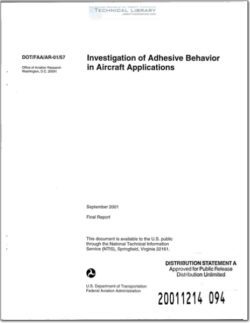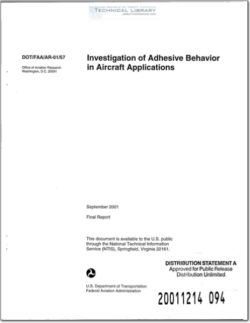DOT-FAA-AR-01-57

- Version
- 286 Downloads
- 2.08 MB File Size
- 1 File Count
- March 23, 2016 Create Date
- March 23, 2016 Last Updated
Investigation of Adhesive Behavior in Aircraft Applications

While the general aviation industry increasingly uses adhesive bonding for airframe composite
structures, several issues have become important, namely, the qualification methods for
adhesives used and the certification of adhesive joints. There is a lack of a generally agreed
upon design methodology for adhesive—bonded composite joints, especially as it concerns the
failure criterion.
There are two parts included in this report. The first part evaluates the most commonly used test
method for adhesive properties, ADTM D 5656 “Standard Test Method for Thick—Adherend
Metal Lap—Shear Joints for Determination of the Stress—Strain Behavior of Adhesives in Shear by
Tension Loading.” Finite element analyses were conducted to simulate the specimen behavior
following the ASTM procedures. It was found that deviations of the measured adhesive shear
modulus from the true value can be as large as 20% if corrections are not made. Correction
factors based on different bondline thicknesses and adhesive properties are provided in the
report.
There are generally three failure modes of adhesive—bonded composite joints: (1) adherend
failure, (2) adhesive failure of the adhesive, and (3) cohesive failure of the adhesive. The second
part of this report provides (1) an analytical model for predicting stress distributions within an
adhesive-bonded composite joint using ASTM D 3165 test specimen dimensions and (2) a
method for predicting joint strength under the adherend failure mode. The analytical model was
verified using a finite element model and comparing the adhesive stress distributions of the two
analyses. A failure analysis was conducted based on four failure criteria. Predicted strengths
were compared with test data. It was shown that the maximum interlaminar axial tensile stress
criteria predict the joint strength better than Tsai-Hill and von Mises criteria.
With the introduction of high performance fibers such as carbon, boron, and Kevlar®, together
with new and improved matrix materials, such as high-temperature thermoplastics, advanced
composites have established themselves as engineering structural materials. An ideal structure
should be designed without joints because joints are normally the weakest part of the structure.
However, the need for assembly, disassembly, inspection, and repair means that some load—
carrying joints cannot be avoided. Adhesive—bonded joints have been widely used for composite
materials as a necessary alternative to conventional mechanical joint designs. The drawbacks of
mechanical joining methods include (1) stress concentrations caused by drilled holes in
laminates, (2) machining difficulties and subsequent damage to the composite laminates, and
(3) weight penalty and fatigue associated with mechanical fasteners.
| File | Action |
|---|---|
| DOT-FAA-AR-01-57 Investigation of Adhesive Behavior in Aircraft Applications.pdf | Download |
Comment On This Post